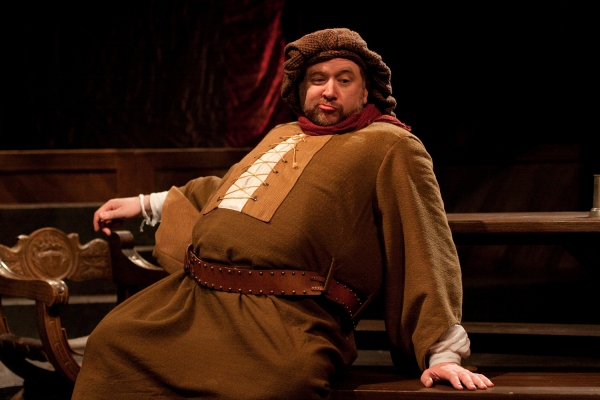
by Steve Cohen
Henry IV Part One by Shakespeare, Lantern Theatre, Philadelphia, 2010
*
Henry IV Part One combines comedy, drama and history, and I recommend this production as a fine introduction to Shakespeare’s history plays. It illumines the lives of two British monarchs, father and son, and introduces the greatest comic character in stage history.
It may be hard for some theater-goers to grasp who’s who among the large number of characters who appear in the opening scene. Director Charles McMahon keeps the rival royals distinct with differing accents and attire. It’s clear to see who are the Scots, who are the Welsh and who the English.
Once past that, we meet the wonderful character of Falstaff, played impressively by Peter Pryor. The overweight, aging knight is larcenous and bawdy but he has great humor and it’s easy to see why young Prince Hal treats him as a surrogate father. Pryor avoids the temptation to bellow and over-act. He plays Falstaff straight so we clearly see the sadness as the man becomes feeble.
Combining three great characters at odds with one another — King Henry IV, his rebellious son Hal, and Falstaff — the play presents human situations that go far beyond the re-telling of British history. We see the anguish of Henry IV as he wonders what his legacy will be, and his disappointment in his son.
Pryor is double cast as the king as well as Falstaff. His changes of costume and demeanor are handled amazingly well, although Pryor does not capture all of the power that’s implied when he’s Henry IV.
Allen Radway is excellent as Prince Hal and Andrew Kane is properly fiery as Hotspur. The other parts are well done too.
The immediacy of the set is impressive. Shakespeare knew what he was doing in this area, as in others, when he used a thrust stage that brought his actors close to the audience. The Lantern’s space on the second floor of St. Stephens Church is small, of course, and in this production the seats are on three sides of the room. McMahon has his actors emerge from all corners of the room and they virtually rub shoulders with the attendees.
Simple but sturdy tables and heavy doors on the fourth wall create a sense of majesty that you would not expect in this loft. Indeed, this is the most royal-looking of all the Shakespeare that I’ve seen recently.
Read other reviews on The Cultural Critic